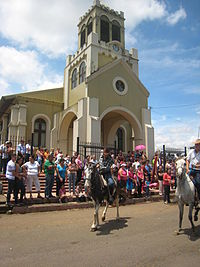
Giovanni di Pietro di Bernardone, known as Francis of Assisi, was an Italian mystic and Catholic friar who founded the religious order of the Franciscans. He was inspired to lead a Christian life of poverty as a beggar and itinerant preacher. One of the most venerated figures in Christianity, Francis was canonized by Pope Gregory IX on 16 July 1228. He is commonly portrayed wearing a brown habit with a rope tied around his waist, featuring three knots that symbolize the three Franciscan vows of poverty, chastity, and obedience.

In religion, a blessing is the impartation of something with grace, holiness, spiritual redemption, or divine will.

Francis of Paola, was an Italian mendicant friar and the founder of the Roman Catholic Order of Minims. Unlike the majority of founders of men's religious orders, and like his patron saint, Francis was never ordained a priest.

Blaise of Sebaste was a physician and bishop of Sebastea in historical Lesser Armenia who is venerated as a Christian saint and martyr. He is counted as one of the Fourteen Holy Helpers.
The anonymous text that is usually called the Prayer of Saint Francis is a widely known Christian prayer for peace. Often associated with the Italian Saint Francis of Assisi, but entirely absent from his writings, the prayer in its present form has not been traced back further than 1912. Its first known occurrence was in French, in a small spiritual magazine called La Clochette, published by a Catholic organization in Paris named La Ligue de la Sainte-Messe. The author's name was not given, although it may have been the founder of La Ligue, Father Esther Bouquerel. The prayer was heavily publicized during both World War I and World War II. It has been frequently set to music by notable songwriters and quoted by prominent leaders, and its broadly inclusive language has found appeal with many faiths encouraging service to others.

The following are Roman Catholic prayers to Saint Joseph.

World Animal Day is an international day of action for animal rights and welfare celebrated annually on October 4, the feast day of Francis of Assisi, the patron saint of animals.
The Litany of the Saints is a formal prayer of the Roman Catholic Church as well as the Old Catholic Church, Anglo-Catholic communities, and Western Rite Orthodox communities. It is a prayer to the Triune God, which also includes invocations for the intercession of the Blessed Virgin Mary, the Angels and all the martyrs and saints upon whom Christianity was founded, and those recognised as saints through the subsequent history of the church. Following the invocation of the saints, the Litany concludes with a series of supplications to God to hear the prayers of the worshippers. It is most prominently sung during the Easter Vigil, All Saints' Day, and in the liturgy for conferring Holy Orders, the Consecration of a Virgin and reception of the perpetual vows of a religious or a diocesane hermit.

The Cathedral Basilica of Saint Francis of Assisi, commonly known as Saint Francis Cathedral, is a Roman Catholic cathedral in downtown Santa Fe, New Mexico. It is the mother church of the Archdiocese of Santa Fe.
The Confraternities of the Cord are pious associations of Christians, the members of which wear a cord, girdle or cincture in honour of a Catholic saint or Angel whom they wish to honour and emulate.

Isidore the Labourer, also known as Isidore the Farmer, was a Spanish farmworker known for his piety toward the poor and animals. He is the Catholic patron saint of farmers, and of Madrid; El Gobernador, Jalisco; La Ceiba, Honduras; and of Tocoa, Honduras. His feast day is celebrated on 15 May.
This is a list of patron saints of places by nation, region, and town or city. If a place is not listed here, it may be listed in "Patronage of the Blessed Virgin Mary".
Religious use of incense has its origins in antiquity. The burned incense may be intended as a symbolic or sacrificial offering to various deities or spirits, or to serve as an aid in prayer.

Chiara Offreduccio, known as Clare of Assisi, was an Italian saint and one of the first followers of Francis of Assisi.

Saint Michael the Archangel is referenced in the Old Testament and has been part of Christian teachings since the earliest times. In Catholic writings and traditions he acts as the defender of the Church and chief opponent of Satan, and assists people at the hour of death.

Tantony is a shorted form of the name of St. Anthony the Abbot, a prominent figure among the Desert Fathers. It is used in reference to the attributes by which the saint is represented. These primarily are the Tantony Pouch, Tantony Bell, Tantony Pig.

St Cyprian's Church is an episcopal church in Beech road, Lenzie, East Dunbartonshire, Scotland. It was built in 1873 by Alexander Ross of Inverness and cost around £2600. The Church has been a category B listed building since 1984.

Carlo Acutis was an English-born Italian Catholic youth and website designer who is best known for documenting Eucharistic miracles and the approved Marian apparitions around the world and cataloguing them onto a website which he created before his death from leukemia. He was noted for his cheerfulness, computer skills, and deep devotion to the Eucharist, which became a core theme of his life. He was beatified by the Catholic Church on 10 October 2020, two days before the 14th anniversary of his death.
The patronal feast of Saint Francis and Saint Catherine is a religious and civil celebration annually held on 4 October in Italy and other locations influenced by Christianity.
Laudato Si' Movement (LSM) is a global network of over 900 Catholic organizations and over 10,000 trained grassroots leaders known as Laudato Si' Animators. Inspired by the Laudato Si' encyclical of Pope Francis, LSM's stated mission is to "inspire and mobilize the Catholic community to care for our common home and achieve climate and ecological justice".


















